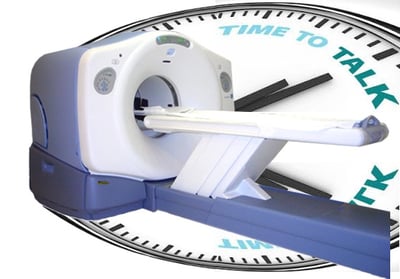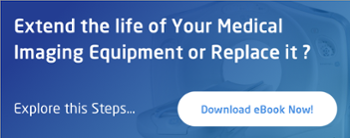It seems we spend a lot of time talking about CT Scans and MRIs in the medical industry, and not nearly as much talking about the PET/CT system. And while it didn’t hit the marketplace until 2001, it brings a lot  to the party and does deserve the spotlight. So here it goes.
to the party and does deserve the spotlight. So here it goes.
First of all, PET stands for positron emission tomography. A PET Scan is a type of nuclear medicine imaging that uses small amount of radioactive materials (called radiopharmaceuticals or radiotracers) to create 3-dimensional color images of the functional processes in the body. It can measure body functions like blood flow, oxygen use and sugar metabolism. The images distinguish between living and dead tissue or between benign and malignant disorders. PET can also create images of disorders at the molecular level, so radiologists can detect abnormalities in cellular activity.
A PET/CT Scan takes positron emission tomography and computed tomography (CT) at the same time, using the same machine. That makes it much easier on the patient, because they only have to go through one sitting instead of two, and they don’t have to change positions, which leaves less room for error. However, an obese person may not be able to fit in the opening of a PET/CT machine.
The CT scan provides detailed three-dimensional pictures of tissues and organs. The image can detect changes in the body structure or anatomy like the size, shape and location of an abnormal growth, tumor or musculoskeletal injury. The PET Scan looks at function and shows how the organ is working. These two scans work together so radiologists can more accurately diagnose, localize and monitor cancer, heart disease and brain disorders.
Common uses of the PET/CT procedure include:
- Detecting cancer
- Determining if cancer has spread or returned after treatment
- Assessing the effectiveness of cancer treatment
- Determining effects of a heart attack
- Determining blood flow to the heart muscle
- Evaluating brain abnormalities, like tumors, memory disorders, seizures and other central nervous system disorders
- Detecting plaques that are associated with Alzheimer’s disease
- Characterizing lesions that are difficult to biopsy
Medicare approved for PET/CT
- Head & Neck
- Thyroid
- Breast
- Lung
- Esophagus
- Colon & Rectum
- Cervix
- Lymphoma
- Melanoma
- Other Cancers
Clinical impact of PET/CT
- More accurate diagnosis
- Avoidance of unnecessary tests
- Better treatment or management
What are the limitations of PET/CT?
- Procedures are time consuming. It can take several hours or days for radiotracers to accumulate in the body part of interest. Because these radioactive materials decay quickly and are effective for only a short period of time, it’s important to receive the materials on time and show up for your appointment on time.
- Test results of diabetic patients can be impacted if they eat within a few hours prior of the scan. It can alter blood sugar and blood insulin levels.
The Good News
When the PET/CT was first introduced, the average cost was around $2.3 million. The price for a new PET/CT has dropped to about half a million, and a refurbished PET/CT can cost one-third to half the price. As prices have dropped, so have scan times.
Want to know more about today’s PET/CT? You might be surprised at how affordable (and revenue-producing!) a refurbished or used PET/CT can be. Talk to an expert at Atlantis Worldwide today by calling Jeff Weiss at 212-366-9100 or jeffweiss@atlantisworldwide.com
Some blogs you may have missed:
- CT Scanner Slice: Handy Guide
- Comparing C-Arms: The Ultimate Guide
- Selling Your Used Medical Imaging Systems vs Trading-in
- Extend Your CT Tube Life by 40% or Greater
- CT Scanner: Air Cooled vs Water Cooled
About the author: Aston Diaz




